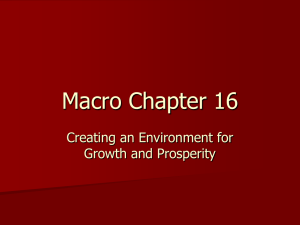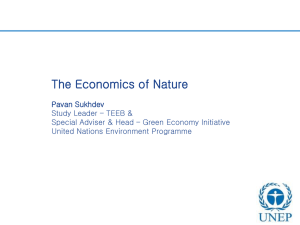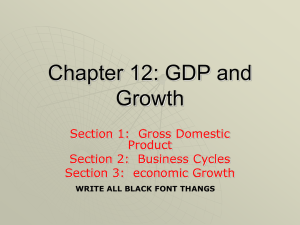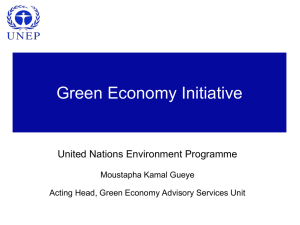PowerPoint Slides - Global Environment Facility
advertisement
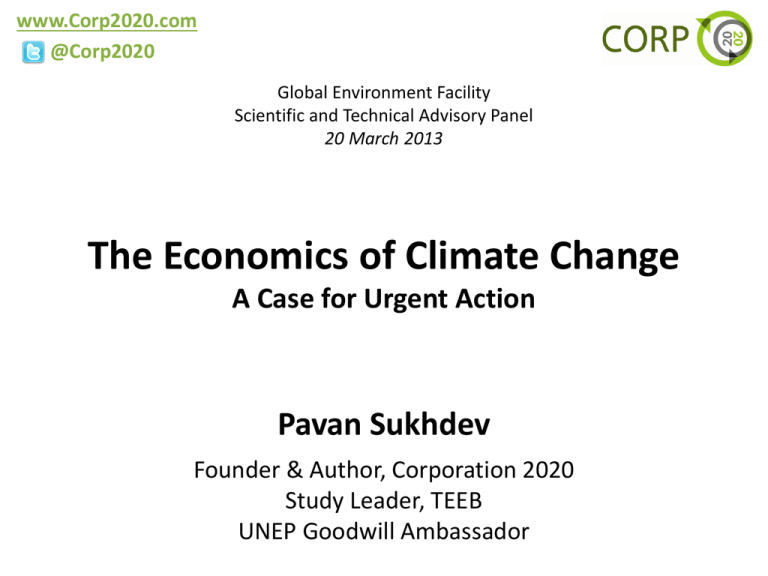
www.Corp2020.com @Corp2020 Global Environment Facility Scientific and Technical Advisory Panel 20 March 2013 The Economics of Climate Change A Case for Urgent Action Pavan Sukhdev Founder & Author, Corporation 2020 Study Leader, TEEB UNEP Goodwill Ambassador www.Corp2020.com @Corp2020 The Greatest Challenge Scientific Assessment for the GEF by STAP team: Climate change is “one of the single greatest challenges – perhaps the greatest challenge – facing humanity” (Nov 2012). “We have it in our hands to overcome these problems through sound policy, collaborative behaviour, a more far-sighted approach to the consequences of our action, and the processes of discovery about technology, organisation and policy.” –Sir Nicholas Stern, in foreword to Corporation 2020 “[W]hat we do in the next 10 or 20 years can have a profound effect on the climate in the second half of this century and in the next.” –Stern Review of the Economics of Climate Change www.Corp2020.com @Corp2020 What will it cost? Stern Review (2006): “If we don’t act, the overall costs and risks of climate change will be equivalent to losing at least 5% of global GDP each year, now and forever. If a wider range of risks and impacts is taken into account, the estimates of damage could rise to 20% of GDP or more.” “In contrast, the costs of action – reducing greenhouse gas emissions to avoid the worst impacts of climate change [stabilizing between 500 and 550ppm CO2e] – can be limited to around 1% of global GDP each year.” •Range is: –1% (net gains) to +3.5% of GDP In 2008, Stern revised his estimate up to 2% of global GDP. And earlier this year, he said that, in contrast to the 2006 report, which said that there is a 75% chance of 2-3 degree rise, he now believes we are “on track for something like four.” We already see 400,000 premature deaths/year from climate change, costing $1.2 trillion, or 1.6% of global GDP. www.Corp2020.com @Corp2020 Summary: What will it cost? • Stern: 2% of GDP = $1.4 trillion/year • International Energy Agency: $38 trillion over 25 years • World Economic Forum: $500 billion/year • UNEP: $1.05 to $2.59 trillion/year to meet MDGs and IEA “Blue Map Scenario”. T-21 model scenario used = $1.3 trillion • Reasonable estimate: $1.5 trillion/year www.Corp2020.com @Corp2020 How much money is available? Fund Amount Japan's Fast Start Finance UK's International Climate Fund Clean Technology Fund (CTF) $15,000 4,640 2,849 Norway's International Climate and Forest Initiative Germany's International Climate Initiative GEF Trust Fund (GEF 5) GEF Trust Fund (GEF 4) Least Developed Countries Fund (LDCF) Pilot Program for Climate Resilience (PPCR) Global Climate Change Alliance (GCCA) 1,608 1,082 1,077 754 540 525 385 Scaling Up Renewable Energy Program (SREP) Special Climate Change Fund (SCCF) 277 259 Australia's International Forest Carbon Initiative Forest Investment Program (FIP) 216 206 Forest Carbon Partnership Facility - Readiness Fund (FCPF-RF) 180 Global Energy Efficiency and Renewable Energy Fund (GEEREF) Adaptation Fund (AF) 170 136 Forest Carbon Partnership Facility - Carbon Fund (FCPF-CF) MDG Achievement Fund Amazon Fund UN-REDD 122 90 33 27 Indonesia Climate Change Trust Fund (ICCTF) Green Climate Fund (GCF) 21 6 Total: $30,201 Millions of $. Cumulative since 2003. Pledged donations. Fund to Fund Transfers Excluded. Data from http://www.climatefundsupdate.org/global-trends/size-spending www.Corp2020.com @Corp2020 www.Corp2020.com @Corp2020 From Macro to Micro: Why the transition to a “Green Economy” needs evolution to “Corporation 2020” U.S. Gross Value Added 7.1% 5.5% 12.5% 74.9% Private Business Households Nonprofit institutions serving households Government Total = GDP (US$14,526.5 billion) 2010 data. Source: U.S. Bureau of Economic Analysis www.Corp2020.com @Corp2020 Micro-Policy Reforms to Make Business Deliver a Green Economy Limiting Leverage : Introducing rules & limits to govern financial leverage Accountable Advertising : Making advertising responsible & accountable via norms & standards Resource Taxation : Taxing the “bads” more & taxing the “goods” less Disclosing Externalities : Measuring & disclosing all major corporate externalities (+ve & -ve) Read more at: www.corp2020.com Source: “Why Corporation 2020?”, Island Press, 2012 www.Corp2020.com @Corp2020 Thank You ! Pavan Sukhdev www.Corp2020.com Founder & Author, Corporation 2020 Study Leader, TEEB UNEP Goodwill Ambassador



